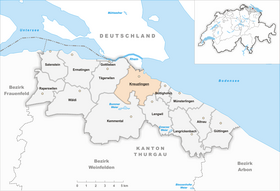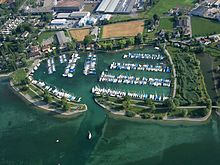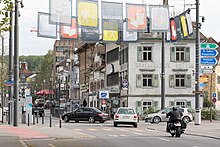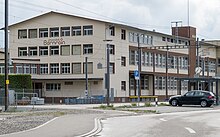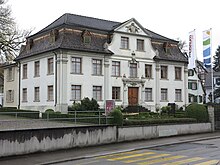Kreuzlingen
| Kreuzlingen | |
|---|---|
| State : |
|
| Canton : |
|
| District : | Kreuzlingen |
| BFS no. : | 4671 |
| Postal code : | 8280 |
| UN / LOCODE : | CH KRZ |
| Coordinates : | 730 734 / 278692 |
| Height : | 397 m above sea level M. |
| Height range : | 395-548 m above sea level M. |
| Area : | 11.50 km² |
| Residents: | 22,004 (December 31, 2018) |
| Population density : | 1913 inhabitants per km² |
|
Proportion of foreigners : (residents without citizenship ) |
55.0% (December 31, 2018) |
| Website: | www.kreuzlingen.ch |
|
Kreuzlingen, viewed in the direction of Bottighofen |
|
| Location of the municipality | |
Kreuzlingen is a political municipality and the capital of the district of the same name in the Swiss canton of Thurgau . From 1927 to 2002 Kreuzlingen was a unified municipality .
With around 22,000 inhabitants, Kreuzlingen is the second largest city in the canton and the largest Swiss city on Lake Constance . Together with the neighboring German city of Konstanz and the smaller neighboring communities ( Bottighofen , Lengwil , Tägerwilen ), the border town forms an agglomeration of around 130,000 inhabitants. With 55.0 percent foreigners, Kreuzlingen is one of the Swiss cities with the highest proportion of foreigners.
geography
Kreuzlingen is located in the north of the canton of Thurgau on the shores of Lake Constance, southeast of the German city of Konstanz and directly adjoining its medieval core. With evidence of a small village structure, Kreuzlingen is located on hillside locations that were once overgrown with vines, surrounded by forests on the hilltops in the south and strongly rural areas behind, with the open, wide Lake Constance to the east and the areas around Seerhein and Untersee to the west.
To the north, the state border with Germany runs through what is now densely built-up area. In the years before the Second World War , the southern border of the city was secured with the Kreuzlingen fortress belt as a defense against an attack from Germany , and the area between the two cities was cut up by a border fence in 1942 (and until August 2006) . In the west Kreuzlingen borders on the Tägermoos and Tägerwilen , in the east the community Bottighofen is close to Kreuzlingen .
Kreuzlingen has an area of 11.50 square kilometers and is 397 m above sea level. M. height (port).
history
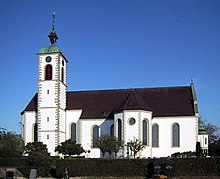

The name comes from the Augustinian canons “crucelin”. It was founded in 1125 by Bishop Ulrich I. von Kyburg-Dillingen from Constance and originally stood one kilometer northwest of today's location. During the Swabian War and during the Thirty Years 'War after the siege of Constance by the Swedes, the Augustinian Canons' Monastery was burned down by Constance residents because they accused the monastery of having been a base for the enemy. In 1650 the monastery was rebuilt at its present location. After secularization in 1848, the Thurgau teachers' seminar moved into the premises; today it is the pedagogical maturity school at the Kreuzlingen seminar (PMS). The former monastery church is now a Catholic parish church.
The area of Kreuzlingen was settled as early as the Bronze Age. Celtic coins and finds from Roman times testify to continuous settlement up to the establishment of the Alemanni . Kurzrickenbach was first mentioned as Rihinbah in 830, Egelshofen in 1125 as Eigolteshoven and Emmishofen in 1159 as Eminshoven . With the exception of the Augustinian Canons' Monastery, the area of today's city was the property of the Bishop of Constance ( Bischofshöri ). With the conquest of Thurgau by the Confederates in 1460 and the Reformation , ties to the neighboring city loosened. At the beginning of the 19th century, today's center of Kreuzlingen was largely arable land, meadows and vineyards. There were 13 houses around the monastery. Egelshofen had about 50 houses, Emmishofen and Kurzrickenbach each about 90 houses. With the reorganization of Europe, Kreuzlingen became a border region. The first customs house was built in 1818. The first steamships that operated on Lake Constance from 1824 and the construction of the railway lines to Romanshorn (1871) and Etzwilen (1875) attracted trade and industry. In 1874, Kreuzlingen became the district capital instead of Gottlieben . But until the First World War the place was a kind of suburb of Constance; Industry in Kreuzlingen was almost exclusively in the hands of German entrepreneurs. It was only when the border was closed during the war that Kreuzlingen became more independent.
The Bellevue Sanatorium (1857–1980) plays a prominent role in the cultural history of Kreuzlingen : Ignaz Vanotti from Konstanz bought a large piece of land in 1842 in the barely built-up area of the old Kreuzlingen Monastery and built a residential and commercial building on it in 1843 for the Bellevue emigrant printing company which was previously set up in the Roman castle. In 1857 Ludwig Binswanger (1820–1880), who had been a psychiatrist in Münsterlingen since 1850 , acquired the property and opened a "private institution for the sick and fostered people from the better classes in Switzerland and abroad". The modern clinic remained under the leadership of the Binswanger for almost 120 years a healing and research center, in which important chapters of psychiatry were lived and written. In 1980 it ceased operations. Of the numerous buildings in the sanatorium, only a few are left today. Residential buildings were built on the site in the 1990s.
→ see also: Sections history in the articles Bernrain , Egelshofen , Emmishofen and Kurzrickenbach
coat of arms
Blazon : split from white with a red cross and red with a white abbot's staff .
The coat of arms was adopted by the canons of Kreuzlingen, which was repealed in 1848 . Red and white ( livery colors ) symbolize innocence and the shed blood of Jesus . The cross on the right can be derived from crucelin , the crosier on the left highlights the monastic past of the place.
Incorporation and change of borders
The then small settlement of Kreuzlingen was initially part of the Egelshofen community . In 1874 the local and municipal community of Egelshofen changed its name to Kreuzlingen and at the same time Kreuzlingen was named the district capital instead of Gottlieben .
In 1879, the border between Switzerland and the German Empire in the area of the Konstanz train station was regulated. The city of Konstanz ceded an area of 10 ares without inhabitants in 1878, while the local community of Kreuzlingen ceded an area of 8.48 ares with 12 inhabitants in the following year.
Kreuzlingen developed into a town in the 20th century with Bernrain , Egelshofen, Emmishofen and Kurzrickenbach . In 1927, through the merger of the local communities Kreuzlingen and Kurzrickenbach (in the east), the unified community of Kreuzlingen was formed. In 1928 it was joined by the former community of Emmishofen (in the west). In 1947 Kreuzlingen became a city when the 10'000. Resident was registered.
population
| 1831 | 1850 | 1870 | 1880 | 1920 | 1930 | 1950 | 1990 | 2000 | 2010 | 2019 | |
|---|---|---|---|---|---|---|---|---|---|---|---|
| Unified municipality of Kreuzlingen | 2426 | 5740 | 8615 | 10'045 | 17'239 | 17,118 | 19'415 | 22,141 | |||
| Local community Egelshofen | 661 | 1152 | 1414 | ||||||||
| source | |||||||||||
Of the total of 21,990 inhabitants of the municipality of Kreuzlingen in 2018, 12,101 or 55.0% were foreign nationals. This high value is primarily explained by the proximity to the border with Germany. 6581 (29.9%) people were Roman Catholics and 4882 (22.2%) were Protestant Reformed.
According to the 2000 census, 79.6% of the population used German, 5.2% Italian, 3.8% Albanian, 2.9% Serbo-Croatian, 2.3% Turkish, 1.3% Spanish, 1.2% Asian languages as their main language , 0.8% Portuguese, 0.5% French and 0.4% English. The remaining 2.0% stated a different main language.
| nationality | December 31, 2018 |
|---|---|
|
|
45.00% |
|
|
29.09% |
|
|
6.05% |
|
|
4.85% |
|
|
2.43% |
|
|
1.15% |
|
|
1.12% |
|
|
0.84% |
|
|
0.79% |
|
|
0.73% |
Church and religion
In Kreuzlingen there is the Evangelical Reformed Church and the Roman Catholic Church .
The local section of the Evangelical Alliance includes: the Chrischona congregation , the Salvation Army and the Pentecostal congregation . There is also a Methodist Church and a New Apostolic Church . There is also a chapel of the "Church of Jesus Christ of Latter-day Saints" ( Mormons ).
A Jewish community had existed in Kreuzlingen since 1939 and was dissolved on January 1, 2016.
There are also two Islamic communities (Albanian and Turkish) and other religious communities.
economy
In 2016, Kreuzlingen offered work for 9,121 people (converted to full-time positions). Of these, 0.3% worked in agriculture and forestry, 28.3% in industry, trade and construction and 71.4% in the service sector.
Viticulture
For centuries, the residents of the communities Emmishofen, Egelshofen and Kurzrickenbach lived mainly from viticulture. Most of the wine produced was exported to Germany across the lake. The area of today's city of Kreuzlingen consisted of a single vineyard for almost half a millennium, which stretched from Bottighofen to Tägerwilen and from Hörnli am See to the Alp. The vineyards were owned by the various open spaces in the area, monasteries from neighboring Germany and the Augustinian canons of Kreuzlingen. In 1579 this alone owned 16 Torkel (wine press ) including Trotten. In 1648 there were 41 Torkels in what is now the municipality. At the end of the 19th century, crop failures, disease and advancing industrialization led to a rapid decline in the vineyards. The last vines grew in Emmishofen in 1920 at Girsberg Castle . In Kreuzlingen, the last vines on the Schelmenhalde were cleared in 1938, but two new vineyards have recently emerged, one on the southern edge of the Seeburg Park (0.5 hectares) with four organic grape varieties and a small field above the town in Bernrain the observatory (planetarium) .
Industry
The largest employer is the armaments company General Dynamics European Land Systems - Mowag GmbH (formerly Mowag AG or Mowag GmbH), a subsidiary of the General Dynamics Company in the United States . Another important employer in the region is the aluminum producer Amcor Flexibles Kreuzlingen AG , which is known under the former name Neher or Alcan.
The best-known company in the clothing industry is Strellson AG (Holy Fashion Group). The Graf Skates AG , manufactures sporting goods especially skates , the company Tour de Suisse Rad AG bicycles. The chocolate manufacturer Chocolat Bernrain AG is also known nationwide .
Other larger companies are Rausch AG (hair and body care products), KG Packungen AG (plastic packaging), Ifolor AG (photo products, founded in 1961 as Photocolor Kreuzlingen AG ) and Neuweiler AG (welding technology and mechanical engineering).
politics
executive
On January 21, 2018, the former city clerk Thomas Niederberger was elected city president.
legislative branch
The city parliament of Kreuzlingen is the 40-member local council . The distribution of seats after the election on March 31, 2019 is as follows:
- SP : 10 seats
- FDP : 8 seats
- SVP : 8 seats
- Free list and greens : 8 seats
- CVP : 4 seats
- EPP : 2 seats
National elections
In the 2019 National Council elections, the share of the vote in Kreuzlingen was: SVP 22.9%, SP 22.8%, Greens 14.5%, FDP 13.9%, CVP 12.9%, glp 8.1%, EVP 2.5 %, BDP 1.4%, EDU 1.0%.
traffic
Kreuzlingen is a railway junction. This is where the lake line (Rorschach – Schaffhausen) meets the Kreuzlingen – Konstanz and Kreuzlingen – Weinfelden railway lines . There are four stations in the city: Kreuzlingen , Kreuzlingen Hafen, Kreuzlingen Bernrain and Kurzrickenbach Seepark.
In order to relieve the binational agglomeration Konstanz-Kreuzlingen from motorized individual traffic, the construction of a S-Bahn Konstanz-Kreuzlingen is being investigated. A tram or a light rail would get the most benefit, but the high cost of the infrastructure calls into question its feasibility.
There are also two motorway connections, Kreuzlingen Süd and Kreuzlingen Nord, to the Swiss A7 motorway , which joins the A1 in Winterthur ; In the direction of Constance there is a connection to the German federal highway 33 via the large GZA (community customs facility) . The section between the state border and the roundabout at the Kreuzlingen Nord junction does not require a vignette in both directions. Other cities can be reached via several main roads . The main road 16 leads to Weinfelden and Wil SG , the 13 to Schaffhausen and Rorschach , the 1 to Frauenfeld , Winterthur and Zurich .
Tourist Attractions
Churches and chapels
- Kurzrickenbach church (12th / 17th century), Protestant Reformed parish church
- Heiligkreuz Chapel (14th century), Roman Catholic , Bernrain
- Church of St. Ulrich and St. Afra (17th / 18th century), formerly the church of the Kreuzlingen monastery , since 1848 a Roman Catholic parish church
- Mount of Olives Chapel (1760), large side chapel on the west side, with baroque mount of Olives scenery with approx. 300 wooden figures
- Egelshofen Church (1724), Evangelical Reformed parish church
- Church of St. Stephan (1903), built in the neo- baroque style , Roman Catholic parish church
Palaces, castles, mansions
There are still ten buildings in the municipality today, which are known as a palace or castle.
Ebersberg Castle
Ebersberg Castle was formerly called Ober-Girsberg . It has been documented since the 16th century. In the 17th and 18th centuries owned by the Kunz family and therefore also called Kunzenhof . In 1816 the well-known surgeon Johann Nepomuk Sauter bought the house, which he converted into a stately villa. In 1848 the building burned down and was rebuilt. In 1867, the textile manufacturer and banker Moritz Macaire (1815–1867) from Constance bought the property for 82,000 Swiss francs , but died two months later. His heirs sold the Kunzenhof to Count Eberhard von Zeppelin , the brother of the airship designer Ferdinand Graf von Zeppelin . Eberhard von Zeppelin expanded the property, had the residential building converted into a castle and named it Ebersberg based on his first name . In 1928 another renovation took place. In 1960 the castle was bought by the German industrialist Friedrich Flick , who had it gutted and refurbished according to plans by the architect Georg Felber.
Brunegg Castle
Also Schloss Brunegg is on Emmi Hofer ground. It should not be confused with the much older Brunegg Castle in the canton of Aargau . The Emmishofer Castle was formerly called Unterer Girsberg . Its predecessor was built around 1300. In 1679 it was bought by the Obermarchtal Abbey on the Danube, and the current building was erected in its place. In 1874 the psychiatrist Ludwig Binswanger (1820–1880) bought the castle and named it Brunnegg. He commissioned the architect Otto Tafel from Stuttgart , who had redesigned the neighboring Castell Castle in Tägerwilen , to convert the castle. Today the Brunegg houses a hotel without a restaurant.
Girsberg Castle
Girsberg Castle was built in its current form in 1790 by the Zwiefalten Monastery as a governor's office . In the course of secularization , the castle fell to the House of Württemberg in 1803 as compensation for the loss of the county of Montbéliard . Friedrich II. , Later the first king of Württemberg, had the palace auctioned in 1803. The Geneva manufacturer and banker Jacques Louis Macaire de L'or , who had settled in Constance, bought it for 26,000 guilders and leased it the following year to Salomon Högger in Bischofszell . Later son David Macaire inherited the castle. One of his daughters, Amélie (1816–1852), married Count Friedrich von Zeppelin (1807–1886), son of the Württemberg Minister Ferdinand Graf von Zeppelin (1771–1829). The couple received the Girsberg as a Christmas present (1840) and together with their children Eugenia, Eberhard and their first-born son Ferdinand Graf von Zeppelin (1838–1917) took up residence at Emmishofer Castle. Ferdinand, the famous airship driver, was the sole owner of Girsberg from 1870 and he spent a lot of time on his estate, mainly in the summer months. After his death, his daughter Hella inherited the Girsberg, which she gave to her daughter Alexa in 1960. In 1983 the Girsberg became the property of Kurt Schmid-Andrist.
Roman castle
The Roman castle was previously known as Rempsberg . The earliest evidence of the house comes from the late 16th century, when Hans Kaspar Morell owned the castle. At the beginning of the 19th century, the then owner Hieronymus Girtanner gave it the name Bellevue , before it was called Römerburg from around 1880.
Gaissberg moated castle
The moated castle Gaissberg stood above the Roman castle. First mentioned in writing in 1328, it was the oldest building in Kreuzlingen. From 1918 to 1920 it was owned by the Luxembourg-born writer Norbert Jacques (1880–1954). In 1964 the last owner of the Gaisberg moated castle, Baroness von Pagenhardt (née Salis ) had it demolished when she moved into a modern single-family house. A three-wing skyscraper was built on the site of the castle in 1969.
Seeburg Castle
In 1598 Jakob Atzenholz from Constance built Seeburg Castle , which later served as a summer residence for the abbots of the Kreuzlingen Augustinian canons' monastery. It burned down completely in 1633 and was restored in 1664. It has housed the Thurgau teachers' college since 1833, and from the mid-1850s belonged to Gottfried Ferdinand Amman, who converted it into the castle in its present-day appearance in 1870 in the historicism style. It has been owned by the city of Kreuzlingen since 1958 and was extensively renovated from 1982 to 1984. Until the lake was filled in in the sixties, the Seeburg stood directly on the shores of Lake Constance.
Bernegg Castle
The Bernegg Castle in Emmishofen is mentioned in a document already Constance 1,292th As the oldest owner of this farm, the Gottschalk family has been proven. Hence the name of the Gottschalkhof. In 1543 Jakob Ammann appears as the owner. In 1623 the estate was again called Bernegg and was owned by Hans Jakob von Bernau von Chur. Under him, the property became a free seat and became the property of the Barons von Rassler. The von Merhart family has owned the castle since 1702.
Irsee castle
The Irsee Castle was built in 1683 by the Irsee Imperial Abbey near Kaufbeuren on the Way of St. James . It served as a summer residence and as a guest house. In 1842 it was bought by the German journalist and publisher Johann Georg August Wirth (1798–1848). He planned to continue the printing company he had previously founded in the Roman castle. Due to financial problems, he had to auction the property in 1844. It was heavily rebuilt in 1943 and 1944 and restored in 1981.
Rock castle
The building from the middle of the 18th century stands on Gaissbergstrasse, which has been called Felsenburg since it was renovated in 1847 . It is not to be confused with the Felsenschlössli on Wasenstrasse.
Felsenschlössli
The Felsenschlössli on Wasenstrasse (not to be confused with the Felsenburg on Gaissbergstrasse) was built before the monastery was built (1650) and later became the property of the monastery, which set up a school there in 1811.
Rosenegg Castle
The Rosenegg is a three-part building complex and is located in the center of the former municipality of Egelshofen at Bärenstrasse 6. The oldest, southern part dates from 1685. This is followed by an intermediate building built in 1750, to which a palace was added in the north in 1784 . The latter was built by the wine merchant and Egelshof mayor, Johann Jakob Bächler (1752–1802), in the classicism style. The Swiss painter Helen Dahm was born in Rosenegg in 1878. In 1895 the Egelshofen school community bought the property to use it as a primary school. In addition to the school, Rosenegg has also been the seat of the local museum since 1937. In 2006 the Rosenegg was taken over by the "Stiftung Museum Rosenegg" and in 2006–2007 it was converted into a new local museum, which now encompassed the entire building (renovation of the original stucco ceiling by Lorenz Schmid from Augsburg , representing the four continents known at the time; redesign of the staircase and the interiors). The museum houses cultural-historical exhibitions of the Kreuzlingen region and shows changing special exhibitions.
Museums
The lake museum is housed in the former grain chute of the Augustinian canons of Kreuzlingen, near the Seeburg castle . The topic is Lake Constance , its shipping and fishing, as well as the region.
There is also the Rosenegg Museum (town history) and a doll museum as well as four art galleries.
In the Roman Catholic parish church of St. Ulrich and St. Afra there is a small museum with objects from the former Kreuzlingen monastery . The Catholic Parish Office of Ortisei grants admission by appointment.
Stumbling blocks
Stumbling blocks were laid in Kreuzlingen for the Swiss citizen Ernst Bärtschi at Schäflerstrasse 11 and for Andreas Fleig at Schäflerstrasse 7 in recognition of their commitment to the persecuted during the time of National Socialism in Germany.
culture and education
Events
Every summer there is an international dance festival in the Dreispitz sports and culture center, the Salsafestival Bodensee with salsa, kizomba, bachata , hip-hop, tango and dance workshops.
Theatrical performances take place irregularly in the "Theater an der Grenz", near the Seeburg and on the Girsberg.
Every year on the second weekend in August, a lake night festival ( called Fantastical in Kreuzlingen ) with fireworks takes place together with the German city of Konstanz , which attracts 50,000 visitors from the region (and far beyond).
Educational institutions
Kreuzlingen is the seat of the Thurgau University of Education (PHTG), which works closely with the University of Konstanz .
The Rudolf Steiner School Kreuzlingen Konstanz is a cross-border educational institution.
Kreuzlingen has two middle schools, the Pedagogical Matura School Kreuzlingen (PMS) and the Cantonal School Kreuzlingen .
In 2002, the second planetarium in Switzerland, the Kreuzlingen planetarium, went into operation. It was built right next to the observatory, which opened in 1976, above the city. Two planetary paths, each six kilometers long, end at the planetarium . The planet path south comes from Siegershausen train station , the planet path north from the Bodensee-Therme Konstanz .
Sports
FC Kreuzlingen , founded in 1905, has been playing in the fifth highest division in football , the 2nd interregional league , since 2013 . The stadium he used from 1931 to 1959 on Konstanzerstrasse ("Grenzland-Stadion") was awarded the fan prize in 2017 by the German Academy for Football Culture (subject: Football Memory of the Year ). AS Calcio Kreuzlingen has also been playing in the 2nd interregional league since 2019 , both clubs from Kreuzlingen operate in the same group. AS Calcio plays its home games in the Döbeli sports complex.
The local swimming club Kreuzlingen (founded in 1926) offers swimming , swimming school and water polo . You can play ice hockey at EHC Kreuzlingen-Konstanz since 1956 . The EHC plays in the Bodensee-Arena , which was the venue for the MLP Nations Cup 2011 .
In Kreuzlingen, the Monday Night Skate ( inline skating ) has been held since 2005 and every year since 2013 with the ITF Kreuzlingen an international tennis tournament for women has been held.
In 2006 the Dreispitz sports and culture center was opened northeast of Bärenplatz .
Town twinning
-
 Cisternino , Italy
Cisternino , Italy -
 Wolfach , Germany
Wolfach , Germany
Personalities
Personalities who were born in Kreuzlingen
- August Gremli (1833–1899), physician, naturalist ( excursion flora of Switzerland, 1867)
- Walter Bissegger (1853–1915), journalist, Cantonal Councilor (1893–1915), National Councilor (1905–1915), President of the FDP (1907–1911)
- Emil Brunnenmeister (1854–1896), lawyer, professor in Zurich, Halle, Vienna
- Enrique C. Rébsamen (1857–1904), educator, emigrated and died in Mexico
- Edgar Steiger (1858–1919), writer and journalist
- Erich Graf von Zeppelin (1873–1927), born in Ebersberg, Rear Admiral of the Imperial Navy
- Walter Enholtz (1875–1961), painter
- Helen Dahm (1878–1968), painter
- Ludwig Binswanger (1881–1966), psychiatrist
- Erich Fischer (1887–1977), musicologist and composer
- Max Werner Lenz (1887–1973), origin. Max Russenberger , actor, director, cabaret artist
- Fritz Blanke (1900–1967), church historian, professor at the University of Zurich
- Jakob Brüllmann (1904–1993), entrepreneur, Cantonal Councilor (FDP) of the Canton of Thurgau 1962–1972
- Eugen Mattes (1904–1980), writer
- Theodor Scharmann (1907–1986), psychologist
- Emil Staiger (1908–1987), Germanist
- Libero De Luca (1913–1997), tenor, opera singer
- Wolfgang Binswanger (1914–1993), psychiatrist and psychoanalyst
- Peter Binswanger (1916–1997), lawyer, insurance specialist, father of the AHV
- Luigi Agustoni (1917–2004), Roman Catholic theologian and church musician
- Siegfried Hildenbrand (1917–1996), organist and composer
- Erich Böckli (* 1919), lawyer, Thurgau government councilor 1965–1986
- Armin Schibler (1920–1986), composer and music teacher
- Peter Schmid (* 1940), politician (Greens) and curative educator
- Thomas Onken (1941–2000), art historian and politician (SP)
- Ueli Sauter (* 1941), undertaker
- Willi Wottreng (* 1948), journalist and book author
- Jossi Wieler (* 1951), theater and opera director
- Christian Lohr (* 1962), politician (CVP)
Personalities who worked in Kreuzlingen
- Peter Babenberg (1461–1545), abbot of the regulated canons of Kreuzlingen 1497–1545
- Jakob Denkinger (1589–1660), abbot of the Kreuzlingen Monastery 1625–1660
- Augustin Gimmi (1631–1696), abbot (called Augustin I) of the regulated canons of Kreuzlingen 1660–1696
- Johann Baptist Dannegger (1682–1760), abbot of the Kreuzlingen monastery
- Prosper Donderer (1715–1779), abbot of the Kreuzlingen monastery
- Jacques Louis Macaire de L'or (1740–1824), lived at Girsberg Castle in Emmishofen from 1803
- Gottlieb Adelbert Delbrück (1822–1890), German entrepreneur and banker. Founder of Deutsche Bank
- Ferdinand Graf von Zeppelin (1838–1917), airship designer, lived in Emmishofen
- Joseph Belli (1849–1927), Schumacher, socialist, member of the “Red Field Post”
- Robert Binswanger (1850-1910), psychiatrist
- Otto Binswanger (1852–1929), pathologist, histologist, professor at the University of Jena
- Hermann Weideli (1877–1964), architect, ran the architecture office “Weideli & Kressibuch” in Kreuzlingen, later “Weideli & Eberli”
- Hedwig Thyssen (1878–1960), daughter of the company's founder August Thyssen
- Norbert Jacques (1880–1954), a Luxembourg-born writer, lived from 1918–1920 at the "Wasserschloss Gaissberg", known for the figure of Dr. Mabuse
- Friedrich Flick (1883–1972), entrepreneur
- Gero von Merhart (1886–1959), prehistorian, professor at the University of Marburg and senior councilor at Bernegg Castle
- Friedel Grieder (1890–1980), Swiss artist, lived temporarily at Bernegg Castle, her work is part of a permanent exhibition in the Rosenegg Museum
- Robert Victor Neher (1886–1918) Swiss industrialist, founded an aluminum rolling mill in Emmishofen in 1910, today Amcor Flexibles Kreuzlingen AG
- Karl Dammer (1894–1977), conductor, general music director in Berlin and Cologne
- Otto Raggenbass (1905–1965), district governor of Kreuzlingen
- Alfred Abegg (1914–1998), Thurgau Cantonal Councilor (1951–1972), National Councilor (1963–1971), Government Councilor (1972–1980)
- Robert Holzach (1922–2009), former SBG Chairman of the Board of Directors (1980–1988)
- Günter Netzer (* 1944), soccer player, entrepreneur
- Urs Kliby (* 1950), entertainer
- Bernhard Schaub (* 1954), Holocaust denier
- Andreas Klöden (* 1975), professional cyclist, second in the Tour de France in 2004 and 2006.
- Tony Martin (* 1985), professional cyclist, world champion individual time trial 2011.
- Guido Bagutti (born October 19, 1923, † February 10, 1981 in Bellinzona ), lecturer, painter and sculptor
literature
- Michael Bürgi, Monica Rüthers , Astrid Wüthrich (eds.): Kreuzlingen - Children, Consumption and Careers 1874–2000. Weinfelden 2001, ISBN 3-85809-124-3 .
- Kreuzlingen mosaic. Reports and pictures from the past and the present; a source book for the border town of Kreuzlingen until around 1960 , City Council Kreuzlingen, Kreuzlingen 1991.
- Alfons Raimann, Albert Knoepfli, Alfred Hungerbühler: Kreuzlingen TG. ( Swiss Art Guide, No. 393/394). Edited by the Society for Swiss Art History . Bern 1986, ISBN 978-3-85782-393-0 .
- Alfons Raimann, Peter Erni: The art monuments of the canton of Thurgau. Volume VII: The District of Kreuzlingen I, The City of Kreuzlingen. (= Art Monuments of Switzerland. Volume 115). Edited by the Society for Swiss Art History GSK. Bern 2009, ISBN 978-3-906131-90-0 .
Web links
Individual evidence
- ↑ Permanent and non-permanent resident population by year, canton, district, municipality, population type and gender (permanent resident population). In: bfs. admin.ch . Federal Statistical Office (FSO), August 31, 2019, accessed on December 22, 2019 .
- ↑ a b c d Localities and their resident population. Edition 2019 . On the website of the Statistical Office of the Canton of Thurgau (Excel table; 0.1 MB), accessed on April 28, 2020.
- ↑ a b c Thurgau in figures 2019 . On the website of the Statistical Office of the Canton of Thurgau (PDF file; 1.8 MB), accessed on April 28, 2020.
- ↑ Swiss land use statistics. Completed on July 1, 1912. Published by the Federal Statistical Bureau. ( Memento from April 12, 2016 in the Internet Archive )
- ↑ a b c municipal coat of arms . On the website of the State Archives of the Canton of Thurgau, accessed on December 8, 2019
- ↑ Monica Rüthers: Germans don't like to go shopping in Switzerland - but that wasn't always the case. In: Neue Zürcher Zeitung from January 19, 2018 .
- ↑ a b c d e population development of the municipalities. Canton Thurgau, 1850–2000 and resident population of the municipalities and change from the previous year. Canton of Thurgau, 1990–2018. On the website of the Statistical Office of the Canton of Thurgau (Excel tables; 0.1 MB each), accessed on April 28, 2020.
- ↑ a b c d Erich Trösch: Kreuzlingen (community). In: Historical Lexicon of Switzerland .
- ↑ STAT-TAB: Swiss Federal Census 2000, resident population by civil law residence ( page no longer available , search in web archives ) Info: The link was automatically marked as defective. Please check the link according to the instructions and then remove this notice. , accessed January 5, 2013.
- ↑ www.each.ch , accessed on March 1, 2012.
- ↑ a b www.kreuzlingen.ch , accessed on March 1, 2012.
- ↑ www.alemannia-judaica.de
- ↑ Kreuzlingen has a new city president. In: Thurgauer Zeitung online, January 21, 2018.
- ↑ List results. (PDF) City of Kreuzlingen, March 31, 2019, accessed on March 31, 2019 .
- ↑ Federal Statistical Office : NR - Results parties (municipalities) (INT1). In: Federal Elections 2019 | opendata.swiss. August 8, 2019, accessed August 1, 2020 .
- ^ Robert Dedecius, Michael Frei: An S-Bahn for the agglomeration of Kreuzlingen - Konstanz. In: Swiss Railway Review No. 1/2020 and 2/2020, pp. 52–54 and 102–104.
- ↑ Stolperstein for Ernst Bärtschi (1903–1983) and Andreas Fleig (1884–1971).
- ↑ bodensee-planetarium.ch , accessed: December 7, 2020
- ^ The gala of the German Academy for Football Culture , supplement to the kicker sports magazine # 86/2017, Olympia-Verlag Nürnberg , October 23, 2017
- ^ Paul Suter: Libero De Luca. In: Historical Lexicon of Switzerland . March 29, 2005. Retrieved December 29, 2019 .
- ↑ Bagutti, Guido. In: Sikart , accessed August 18, 2015
Remarks
-
↑ In the area of today's municipality of Kreuzlingen, 2367 inhabitants lived in 1850. ( Population development of the municipalities. Canton Thurgau, 1850–2000. On the website of the Office for Statistics of the Canton Thurgau (Excel table; 0.1 MB), accessed on April 28, 2020.)
At that time, 695 inhabitants lived in the local municipality Emmishofen Verena Rothenbühler: Emmishofen. In: Historisches Lexikon der Schweiz .)
And in the local community Kurzrickenbach 520 inhabitants. (Erich Trösch: Kurzrickenbach. In: Historisches Lexikon der Schweiz .) - ↑ a b without the local community Kurzrickenbach and unit community Emmishofen, which were independent until 1927 or 1928


